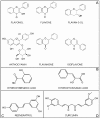In vitro and in vivo antitumoral effects of combinations of polyphenols, or polyphenols and anticancer drugs: perspectives on cancer treatment
- PMID: 25918934
- PMCID: PMC4463587
- DOI: 10.3390/ijms16059236
In vitro and in vivo antitumoral effects of combinations of polyphenols, or polyphenols and anticancer drugs: perspectives on cancer treatment
Abstract
Carcinogenesis is a multistep process triggered by genetic alterations that activate different signal transduction pathways and cause the progressive transformation of a normal cell into a cancer cell. Polyphenols, compounds ubiquitously expressed in plants, have anti-inflammatory, antimicrobial, antiviral, anticancer, and immunomodulatory properties, all of which are beneficial to human health. Due to their ability to modulate the activity of multiple targets involved in carcinogenesis through direct interaction or modulation of gene expression, polyphenols can be employed to inhibit the growth of cancer cells. However, the main problem related to the use of polyphenols as anticancer agents is their poor bioavailability, which might hinder the in vivo effects of the single compound. In fact, polyphenols have a poor absorption and biodistribution, but also a fast metabolism and excretion in the human body. The poor bioavailability of a polyphenol will affect the effective dose delivered to cancer cells. One way to counteract this drawback could be combination treatment with different polyphenols or with polyphenols and other anti-cancer drugs, which can lead to more effective antitumor effects than treatment using only one of the compounds. This report reviews current knowledge on the anticancer effects of combinations of polyphenols or polyphenols and anticancer drugs, with a focus on their ability to modulate multiple signaling transduction pathways involved in cancer.
Figures
References
-
- Manach C., Scalbert A., Morand C., Rémésy C., Jiménez L. Polyphenols: Food sources and bioavailability. Am. J. Clin. Nutr. 2004;79:727–747. - PubMed
Publication types
MeSH terms
Substances
LinkOut - more resources
Full Text Sources
Other Literature Sources


